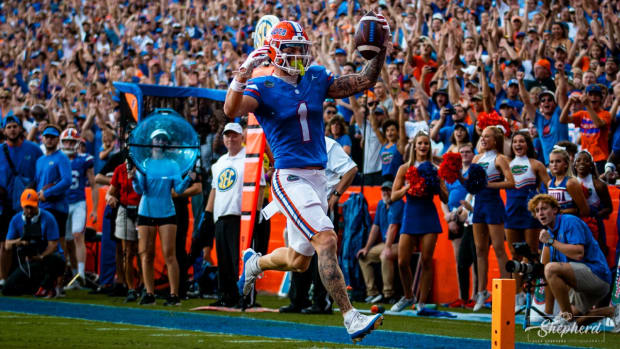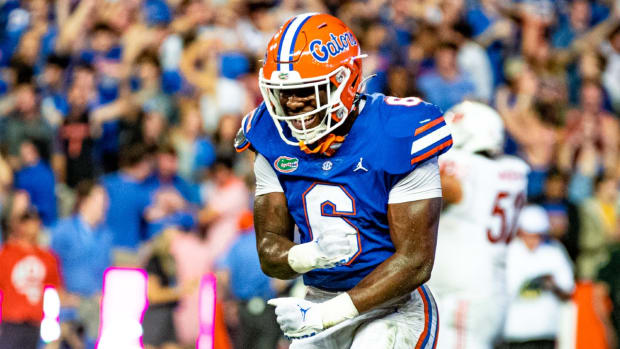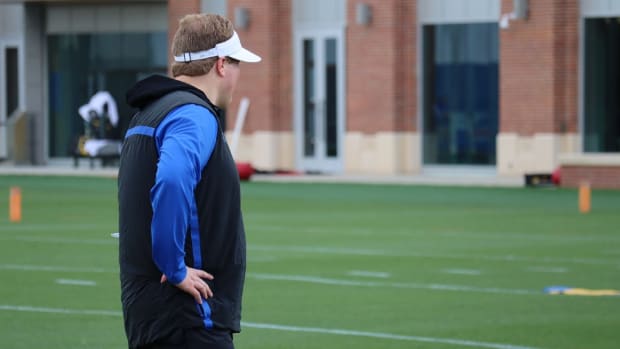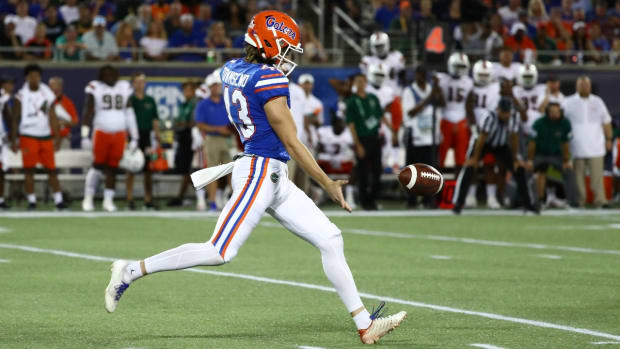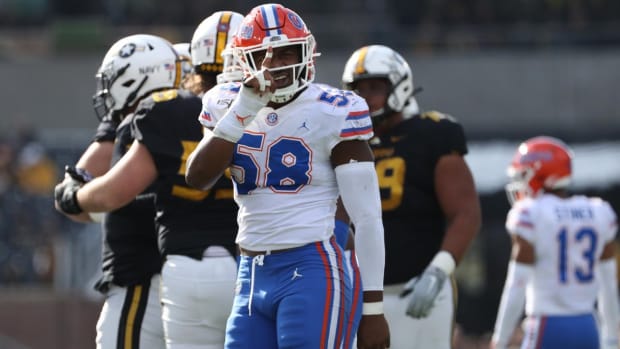Considering Replacements for the Florida Gators' Most Productive Departures
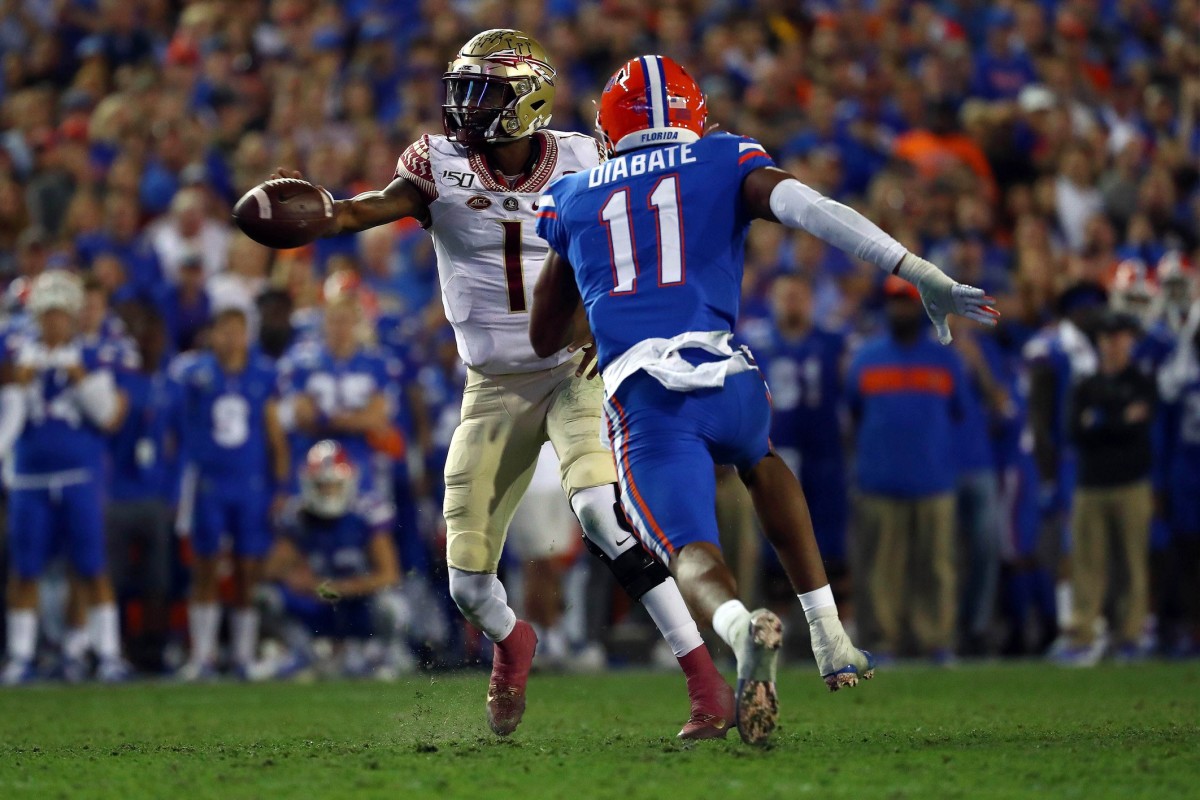
Rewinding back to the 2019 season, the Florida Gators shocked the nation as they went 11-2 and won the Orange Bowl in Dan Mullen's second season as the Gators' Head Coach. Despite multiple injuries to key players throughout the season, the Gators still won 11 games and finished the season ranked sixth in the nation.
Moving into 2020, the Gators will have to replace some of their most prized players from last season, such as C.J Henderson, Jabari Zuniga, Van Jefferson, and others.
The attrition the Gators are facing is a concern, but many of these holes can be filled with players that have the potential to be even better than their successors.
Strong-side DE: Jabari Zuniga --> Zachary Carter
At the strong-side defensive end spot, redshirt junior Zachary Carter will replace third-round draft pick, Jabari Zuniga.
Zuniga was dealing with an ankle ailment for much of the 2019 season, which allowed Carter to step in and get valuable experience heading into 2020. Throughout 2019, the 6-4, 287-pound defensive end (he's up from 264 lbs., per his Twitter) accumulated a total of 30 tackles and finished the year with 4.5 sacks, the second-most on Florida's SEC-leading pass rush. He also tallied 20 quarterback pressures, tied for third-most on the team per Pro Football Focus.
Carter rotated around the defensive line and had varied success at each of the positions, including SDE and three-technique tackle. Carter has everything you could ask for in a defensive lineman prospect, with a quick burst off the ball and the strength of an ox.
Due to Carter's production last season, this is one of the least concerning spots on this entire list. Carter is well aware of his responsibilities and has already proven himself as a playmaker on the defensive front. If everything goes as planned, we may be talking about replacing Carter in about a year's time should he look to the NFL.
Cornerback: C.J. Henderson --> Kaiir Elam
Sticking on the defensive side of the ball, Kaiir Elam will replace the ninth pick of the 2020 NFL Draft, C.J Henderson.
Similar to Carter, Elam was forced to step into a starting role due to injuries and had no issues. Elam was an impact player as a freshman, so much so that the SEC coaches selected him to the Freshman All-SEC team.
Elam was a forced to be reckoned with, that is when the ball came to his side. Many teams shied away from Elam's side, which was a wise decision. When targeted in coverage, the 6-2, 187-pound corner often made big plays on the ball, tallying three interceptions and four pass breakups.
According to PFF, Elam allowed only 43.5% of his 23 targets to be caught, which ranked ahead of every member of Florida's starting secondary throughout the year including Henderson. One of several impressive PFF stats, Elam also allowed a passer rating in coverage of 18.3 - for reference, a quarterback's passer rating would be 39.6 if he spiked the ball on every snap.
Sure, replacing C.J Henderson is going to be near impossible, but Florida is just where they want to be with Elam stepping into a starting role.
Running back: Lamical Perine --> Dameon Pierce
In the offensive backfield, Lamical Perine has departed from Gainesville and has found a home in New York, alongside Zuniga with the Jets.
Perine was one of the best running backs to come through Florida in recent memory as he continued to produce despite having a below-average offensive line in his senior year. When Perine wasn't grinding out yard after yard on the ground, he was acting as a polished pass-catcher who had over 40 receptions throughout the 2019 season.
Looking forward, junior Dameon Pierce will welcome the 2020 RB1 spot, with newly acquired Lorenzo Lingard following close behind him. Pierce is no stranger to Mullen's system, as the junior has contributed to the Gators' run game throughout his first two seasons in Gainesville, posting 729 yards on only 123 carries with seven touchdowns.
Pierce too can grind out tough yards, as 4.43 of his 5.6 yards per carry in 2019 came after contact (PFF).
Although there is little concern that Pierce can replicate the production that Perine had on the ground, the question will be if Pierce can also contribute in passing game. Throughout two years, Pierce has only nine receptions for a mere 50 yards. It would be nice to see some more development from Pierce in this aspect, but with a deep running back core, this may not be a problem due to the other backs Mullen has at his disposal, such as Malik Davis.
Middle linebacker: David Reese II --> Derek Wingo
Perhaps the biggest question mark among all the departures is who will replace the production of middle linebacker David Reese II. Reese stuffed the run like no UF linebacker in recent memory and always clutched up in short-yardage situations.
Now, Reese was often a liability in coverage, which is exactly why Derek Wingo could step in and be a major player in the middle for the Gators. Where Reese lacked in coverage, Wingo makes up for with excellent speed and coverage skills which will translate well to the college level. Wingo punishes rushers similar to Reese, but can also add a new level of speed in which Reese lacked.
There's no doubt that college transition is one that is very difficult, but if anyone could make it happen, it would be Wingo.
If Wingo isn't ready, the linebacker depth chart is filled with other, more experienced options, such as James Houston IV and Ventrell Miller. However, it's tough not to love Wingo's potential to play early - two seasons after transitioning from quarterback to defensive end and linebacker at St. Thomas Aquinas, Wingo earned Gatorade's Florida Football Player of the Year Award.
Wide receiver: Four NFL-bound WRs --> Trevon Grimes & Jacob Copeland
After losing four receivers to the NFL, the Gators will need to replace almost all of the wide receiver production from 2019. Both Jacob Copeland and Trevon Grimes will be the main targets for quarterback Kyle Trask in 2020, joining Kyle Pitts at tight end and slot receiver Kadarius Toney. If cleared by the NCAA following his transfer from Penn State, Justin Shorter could also contribute early on.
In 2019 alone, Grimes amassed 33 catches for 491 yards with three touchdowns. This was good enough for fourth on the team in receiving yards, only falling behind Pitts, Jefferson, and Swain. A deep threat, Grimes averaged 14.9 yards per catch with 8.2 coming after the catch, per PFF.
In his redshirt freshman season, Copeland posted 21 catches for 273 yards and two touchdowns. Grimes and Copeland have been waiting patiently for their turn, and I expected both of them to have productive seasons as there are fewer targets to fight over after the loss of Van Jefferson, Josh Hammond, Freddie Swain, and Tyrie Cleveland.
Numbers-wise, the stats don't jump off the page as two who will make up for the loss of four NFL players. However, both are more than capable of picking up the slack with some help from some others in the room.
Dionte Marks, Trent Whittemore, and Ja'Markis Weston will also be rotated in occasionally, but we will have to wait until practice starts to know exactly what order they fall in. 2020 signee Xzavier Henderson will also see early playing time with the lack of experienced depth in the Florida wide receiver room.
BUCK rush end: Jonathan Greenard --> Khris Bogle & Mohamoud Diabate
At BUCK, sophomores Khris Bogle and Mohamoud Diabate will be the leaders at defensive coordinator Todd Grantham's fine-tuned edge-rushing spot. Although both Bogle and Diabate made leaps in their first seasons, former five star Brenton Cox will also be vying for reps at BUCK.
As of now, I could see Bogle taking over the spot for first and second down as his longer frame makes it easier for him to stop the run, with Diabate coming in on third down to rush the passer more effectively with his pure speed. Grantham often turns up the heat with blitzes on third-down situations, and DIabate's speed certainly fits the mold of those packages.
In their freshmen seasons, Diabate and Bogle both offered solid production. Bogle finished his year with 18 tackles, two sacks, and seven quarterback pressures, while Diabate totaled 14 tackles, four sacks, and 21 quarterback pressures.

